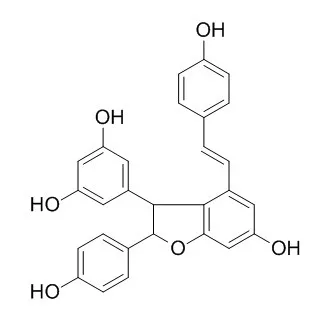| Kinase Assay: |
| Cell Immunol. 2014 Jul;290(1):21-9. | | Anti-inflammatory mechanism of α-viniferin regulates lipopolysaccharide-induced release of proinflammatory mediators in BV2 microglial cells.[Pubmed: 24859013] | α-Viniferin is an oligostilbene of trimeric resveratrol and has anticancer activity; however, the molecular mechanism underlying the anti-inflammatory effects of α-Viniferin has not been completely elucidated thus far. Therefore, we determined the mechanism by which α-Viniferin regulates lipopolysaccharide (LPS)-induced expression of proinflammatory mediators in BV2 microglial cells.
METHODS AND RESULTS:
Treatment with α-Viniferin isolated from Clematis mandshurica decreased LPS-induced production of nitric oxide (NO) and prostaglandin E2 (PGE2). α-Viniferin also downregulated the LPS-induced expression of proinflammatory genes such as iNOS and COX-2 by suppressing the activity of nuclear factor kappa B (NF-κB) via dephosphorylation of Akt/PI3K. Treatment with a specific NF-κB inhibitor, pyrrolidine dithiocarbamate (PDTC), indirectly showed that NF-κB is a crucial transcription factor for expression of these genes in the early stage of inflammation. Additionally, our results indicated that α-Viniferin suppresses NO and PGE2 production in the late stage of inflammation through induction of heme oxygenase-1 (HO-1) regulated by nuclear factor erythroid 2-related factor (Nrf2).
CONCLUSIONS:
Taken together, our data indicate that α-Viniferin suppresses the expression of proinflammatory genes iNOS and COX-2 in the early stage of inflammation by inhibiting the Akt/PI3K-dependent NF-κB activation and inhibits the production of proinflammatory mediators NO and PGE2 in the late stage by stimulating Nrf2-mediated HO-1 signaling pathway in LPS-stimulated BV2 microglial cells. These results suggest that α-Viniferin may be a potential candidate to regulate LPS-induced inflammation. | | Food Chem Toxicol. 2014 Jul;69:276-80. | | Potent inhibitory effect of alpha-viniferin on human cytochrome P450.[Pubmed: 24769006] | α-Viniferin isolated from Caragana chamlagu is a trimer of resveratrol, and has several biological activities, which include anti-inflammatory, anti-oxidant, anti-arthritis, and anti-tumor activities. Herb-drug interactions are the source of the most harmful complications in patients coadministered herbal and modern medicines, and are caused by modulation of the activities of drug metabolizing enzymes.
METHODS AND RESULTS:
Here, the authors investigated the inhibitory effects of α-Viniferin on the activities of 9 human cytochrome P450 (CYP) isoforms using a cocktail of probe substrates and LC-MS/MS in pooled human liver microsomes (HLMs). α-Viniferin strongly inhibited 7 of the 9 CYP isoforms (except CYP2A6 and CYP2E1). Furthermore, α-Viniferin strongly inhibited CYP2C19-mediated omeprazole 5-hydroxylation and CYP3A4-catalyzed midazolam 1-hydroxylation with IC50 values of 0.93 and 1.2 μM, respectively. α-Viniferin strongly inhibited the activities of these two CYPs dose dependently, but not time-dependently.
CONCLUSIONS:
Lineweaver-Burk plots and secondary plots indicated a typical pattern of mix-mode inhibition for CYP2C19 and 3A4. This is the first investigation conducted on the inhibitory effect of α-Viniferin on CYP2C19 and 3A4 in HLMs to predict a potential herb-drug interaction. |
|






 Cell. 2018 Jan 11;172(1-2):249-261.e12. doi: 10.1016/j.cell.2017.12.019.IF=36.216(2019)
Cell. 2018 Jan 11;172(1-2):249-261.e12. doi: 10.1016/j.cell.2017.12.019.IF=36.216(2019) Cell Metab. 2020 Mar 3;31(3):534-548.e5. doi: 10.1016/j.cmet.2020.01.002.IF=22.415(2019)
Cell Metab. 2020 Mar 3;31(3):534-548.e5. doi: 10.1016/j.cmet.2020.01.002.IF=22.415(2019) Mol Cell. 2017 Nov 16;68(4):673-685.e6. doi: 10.1016/j.molcel.2017.10.022.IF=14.548(2019)
Mol Cell. 2017 Nov 16;68(4):673-685.e6. doi: 10.1016/j.molcel.2017.10.022.IF=14.548(2019)